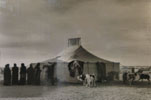Carlos Reyes-Manzo and Bill Samuel’s photography exhibit, Children of the Clouds, at Foyles Bookshop in London is a showcase of the Saharawi refugees’ lives in the arid landscape of the Sahara desert, where they have lived in exile for more than 25 years. The exhibit, which ends 23 June, showcases photos taken in January and February at four refugee camps in the Tindouf area of Algeria.
By Jami Oetting from Index on Censorship
“For the tourists who go to Morocco to enjoy the beautiful blue skies and the sun, the desert is very romantic. But there is nothing romantic about living as an exile for over 30 years in the desert in one of the harshest environments on earth completely forgotten by the international community,” Reyes-Manzo says of the project. Bill Samuel, a director of Foyles and amateur photographer, accompanied Reyes-Manzo and a selection of his photographs are also on display.
The refugees from Western Sahara, who live in a land of limbo in Southern Algeria, are the result of the bartering of their land by neighbouring countries in the 1960-70s. Spain had agreed to decolonise Western Sahara in 1966, following the trend of other European countries that were also giving up colonies in Africa. Before Spain gave control to The Polisario Front, the group fighting for an independent state, Spain made a deal allowing Morocco and Mauritania to assume control over the territory they then divided.
Morocco and Mauritania invaded, causing Saharawis to flee into the Polisario controlled area and Algeria’s southern area of Tindouf while the Front continued to battle for independence. Mauritania retreated in 1979 and a ceasefire with Morocco was accomplished in 1991 through a United Nations resolution. Polisario accepted the UN peace plan, MINURSO, and they were promised a referendum allowing Saharawis to choose between independence and integration with Morocco. While the cease-fire has been maintained, the referendum has yet to occur.
An Endless Exile
In the meantime, nearly 200,000 refugees, 80 percent of whom are women and children, are living in an almost uninhabitable land of the Sahara desert where temperatures can reach 57 degrees Celsius and the only water supply arrives in tankers. The Berm of Western Sahara or the ‘Moroccan Wall’ is surrounded by landmines, separating the refugees and the government in exile, Saharawi Arab Democratic Republic, from their homeland. Reyes-Manzo’s black and white photos depict a homeless people who see their lives in a place of limitless sand as still temporary; many people continue to live in tents. Barbed wire is the only structure that resembles anything like foliage and faces appear rough from years of waiting under a relentless sun.
But the photographs also reflect scenes of a community that has formed. Children, who have never seen the homeland they wait for, jump rope and play football. Happiness radiates from the women’s faces at a wedding scene. Reyes-Manzo wrote in the information for the exhibition, “Women are the spirit of the family and community, handing down traditions through the generations…” The Saharawi women had created a community in the camps by establishing an education system, day care facilities, and healthcare services soon after they arrived.
One photograph of Barchari Daf, a man wounded during the war, exemplifies the weariness and isolation felt by the people in many of the pieces. The caption, like the others, reads pieces of poetry written by Reyes-Manzo. “And dreams of returning to the sea/ go again and again to the wall/ then the fire of machine guns/ breaks the bodies piece by piece.”
Foyles is located at 113-119 Charing Cross Road, London, WC2H 0EB





